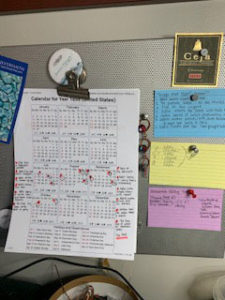(Just a small aside and gripe: I wrote this entire blog post and it was just eaten by the Internet! I will try again.)
My April efforts for my class, Novel in Nine, fell a bit short. There was out of town company, there was sickness, there were other challenges, but I used the last few hassle-free days to catch up, so my final word count for the month was 38K+, a good showing but no cigar (40K).
My topic today is the use of calendars when writing your story. Not the use of calendars to keep YOU, the writer, on track, but using them to keep your story on track. I’m such a sucker for using devices when I write, like personality questions, color coding, lists, etc., that I don’t know why calendars aren’t a common ‘thing’ with writers. (Or maybe they are and I just don’t know it!) It’s another device I find useful.
I first started using a calendar for writing NaNoWriMo stories, and this is how I wrote Virtually Yours. I assigned each of the characters a day and wrote from their point of view on that day, with the last few days of the month ending up a melange of POVs to wrap the story up. It’s a no-brainer to use a calendar during NaNo, the yearly story telling blitz. You are tasked with writing a first draft (albeit, as we know, a messy first draft) in thirty days – a total of 50K words. As a result of my using a calendar for NaNo, most of my “November” stories are thirty days in duration. They typically start on or about November 1 and end November 30. I will take a monthly calendar page to plot out the action, or use my Hobonichi or other notebook to make one myself.
For Finding Cadence, I didn’t employ the use of a calendar until maybe the third draft. (I wrote this story before Virtually Yours but didn’t start editing until after…way after.) I needed the calendar because the story was very long and confusing to my beta readers. It was so long I ended up breaking it into three distinct parts while I sought to edit out many thousands of words. It was about the same time I plotted the story on a calendar that I found the story was following three distinct movements of a Rachmaninoff piano concerto that I listened to every time I sat down to write. Finding Cadence takes place from early February to October of the same year, and I printed up monthly calendar pages and stuck them together. Using the calendar helped me balance each of the parts so that they were about equal in actual word count size and story.
Since I’m currently writing a historical novel set in 1898 Colorado Springs, there was much research to be done. Once I began researching, I found that I had to keep the story somewhat ‘real.’ While it’s fiction I’m writing, I’m mentioning actual people and places and events, such as the Antlers Hotel fire (which occurred on a Saturday afternoon, who knew?). I didn’t want a bunch of history buffs nitpicking my story over days of the week! So I printed out a calendar for the year 1898 so I could visualize the story’s movement. The story starts Monday, July 4, when Silas dies, and ends Monday, October 3. My calendar is on a peg board right in front of me.
I’m making some strides this month. Now that I have much of the novel completed (about 55%) and I know at least in my head where the plot is going, it was time to take down my calendar and update it, along with the random business cards where I’ve written notes. After updating the calendar, I went back into my draft and put notes (chapters) along the way that correspond to the events that I have laid out or have already written.
I’m not writing this story in a linear fashion (although I started out writing it that way!); I have a solid beginning, a fairly good ending, and much in between. What I’m doing now is going back to fill in the holes in the story. The calendar is a constant reminder of the holes I need to plug up with scenes or chapters that I know have to be included before I can be reasonably satisfied with the first draft. The note cards are reminding me of specific things I need to include or work on.
Okay, so I’m a dinosaur but I made the transition from a manual typewriter to a computer. Someday I might graduate from Word to Scrivener. Like on a week where I have time. 🙂
Until then, I use calendars as a visual time line. It keeps me from wandering, which as we know, I tend to do.








